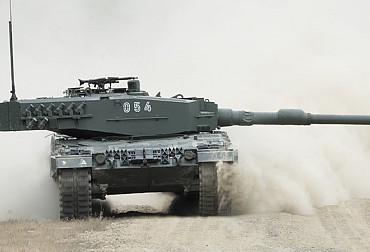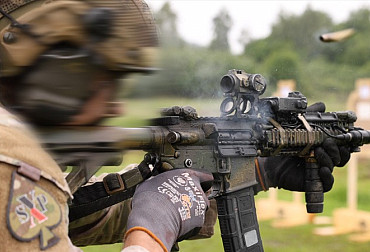The Czech army is testing new special Pandur II armoured vehicles
In January 2017, the Czech Ministry of Defense signed a contract with Tatra Defence Vehicle to buy 20 Pandur II CZ armoured vehicles in two special versions. The demanding project has come to a successful end, and the army will soon be delivered the first vehicles.
The Czech Army will get six wheeled armoured command-staff vehicle (KOVVŠ) and 14 wheeled armoured liaison vehicles (KOVS). Six field command posts will also be delivered. The 8x8 wheeled vehicles will serve at the 4th Brigade´s headquarters and the headquarters of the individual battalions of the Brigade.
.jpg)
Picture: The Czech Army will get six wheeled armoured command-staff vehicle (KOVVŠ) and 14 wheeled armoured liaison vehicles (KOVS). Six field command posts will also be delivered. | Tatra Defence Vehicle
By manufacturing the Pandur II CZ vehicles, Tatra Defence Vehicle and cooperating companies and institutions, such as Retia, the Military Research Institute, VÚT (the Military Technical Institute of Ground Forces of the Czech Army), Ray Service, Optokon, Interlink CS, B.O.I.S. Filtry and others, proved again the extraordinary capability of the Czech defense industry to develop and deliver the world class military vehicles with a modern electronic equipment.
These days, the Czech army is conducting the acceptance tests for the armoured vehicles. After the tests are completed, all the contracted special Pandurs II will be manufactured and delivered. Thus, the army will get the first four examples this year, while the remaining 16 will be delivered by the end of 2020.
.jpg)
Picture: Production of armored vehicles Pandur II | DP
The wheeled armoured liaison vehicles (KOVS) are designed to ensure support and interoperability of command and control systems for battalions and brigades. The technical and electronic equipment of KOVS vehicles allows to process information up to the level secret.
The wheeled armoured command-staff vehicle (KOVVŠ) will provide support in the decision-making processes of brigade/battalion commanders. The carriers will help to streamline the process of command and control of the subordinate elements. Also in KOVVŠ vehicles, the technical and electronic equipment allows to process information up to the level secret.
The KOVVŠ will be delivered together with the field command posts. These are special inflatable tents (8 x 5.7 x 3 m) with a capacity of 10 workplaces, equipped with computer terminals. They will enable to expand the number of staff of the superior command levels directly on the battlefield.
.jpg)
Picture: Special Pandur II armoured vehicles | Tatra Defence Vehicle
Due to their specific purpose and construction, the new KOVVŠ and KOVS Pandurs II are slightly different from the Pandurs II already in use by the Czech army. The interior of the hull is more spacious than, for example, in the KBVP Pandur II – infantry fighting vehicle version, mainly due to a smart installation of a number of electronic systems. For comparison, KBVP´s interior space is 13.12 m3, whereas it is 14.4 m3 for KOVS and KOVVŠ. Interestingly, the interior space has grown mainly thanks to the hull heightening. Both types are designed to transport four crew members - the driver, the vehicle commander and two electronic systems operators. The crew is seated on the new BOG-AMS-V anti-explosion seats of the Czech origin. The crew can also make use of a stand-alone electric power system.
%20FOTO%20DP.jpg)
Picture: Pandur II KOVVŠ | | Tatra Defence Vehicle
The most significant change compared to the Pandurs II already used by the Czech army is that the KOVS and KOVVŠ possess an increased ballistic and anti-mines protection of vehicles at the level of 3 / 3a according to STANAG 4569. This level of protection has been implemented thanks to installing new additional plates of ceramic armor and reinforcing the undercarriage parts of the vehicle. Due to the change, the total weight of both vehicle types has increased compared to previous versions of Pandur II, and that is why their braking system has been reinforced, while losing its swimming capability.
The KOVVŠ vehicles are equipped with a number of systems for secret and non-secret voice and data connection in the VHF and UHF bands. It is mainly the AN / PRC-117G radio station located in the commander's area, then the INMARSAT BGAN terminal, two VHF / UHF antennas and a SATCOM antenna. It is because of the installation of a telescopic antenna mast, which can extend to a height of more than 10 m, that KOVVŠ and KOVS Pandurs are equipped with hydraulic chassis supports for a better stability.
.jpg)
Picture: Pandur II KOVS | Tatra Defence Vehicle
To ensure high-capacity data transmission, KOVVŠ vehicles are equipped with a radio relay link, which consists of the RF-7800W-IU200 unit, as well as a system of automatic directional antenna, RF-7800W-OU500 radio station, directional antenna, omnidirectional antenna and a speakerphone. The vehicles are also equipped with systems for secret and non-secret data and voice connections within the network infrastructure and intercom for the crew.
The KOVS vehicles are equipped with similar systems for secret and non-secreted voice and data connection in the VHF and UHF bands as in the case of KOVVŠ vehicles. In addition, they possess two AN / PRC-117G radio stations located with the second operator. The equipment for secret and non-secreted data and voice connections within the network infrastructure and intercom equipment for the crew is similar to the KOVVŠ vehicles, only with minor changes. Unlike the KOVVŠ version, KOVS vehicles are also equipped with systems of secret and non-secreted voice and data communication in the HF band.
The new Pandurs II possess no integral weaponry or combat stations, but a carriage for the MINIMI light machine gun of caliber 7.62 mm is installed at the commanders post. However, 600 pieces of ammunition are on board as well.
.jpg)
Picture: Pandur II KOVS | Tatra Defence Vehicle
Powerpack of the new special Pandurs II is identical to the Pandurs II already in use in the Czech army. The six-cylinder Cummins ISLe T450 HPCR turbo-diesel engine with a power output of 335.6 kW secures up to 100 km / h velocity, while carrying 22 tonnes. The vehicles´ longest range is about 700 km. The KOVS and KOVVŠ easily overcome trenches with a width of up to 2.2 m, vertical obstacles to a height of 0.6 m and they wade through the water up to 1.5 meters.





















